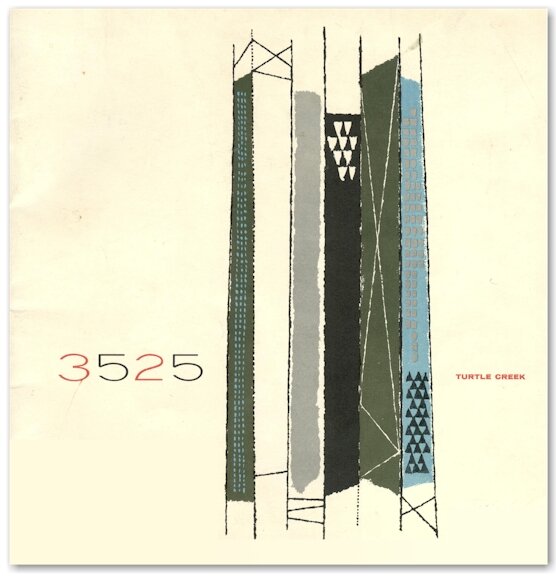the history of 3525 Turtle Creek Boulevard
– Photos and info courtesy of 3525 Turtle Creek and howardmeyer.org
Located near the Katy Trail in the exclusive Turtle Creek area of Dallas, the 22-story “3525” is minutes from parks, dining, shopping, theatre and entertainment in Downtown, Uptown, and Oak Lawn. When it opened to the public, 3525 Turtle Creek was the ”tallest, largest, and most luxurious apartment ever erected west of the Mississippi” and it has been home to many of Dallas' notable citizens.
Although originally available in five floor plans, Legendary Living is now offered in a variety of configurations. Amenities include a workout room, 24-hour doorman, complimentary valet services for residents and visitors, and a guest apartment. The historic Turtle Room overlooks a shaded swimming pool.
Designed by famed Modernist architect Howard R. Meyer and constructed in 1957 by Jerome J. Frank and Edward T. Dicker, the building is one of the nation's few Modernist high-rise apartment buildings listed in the National Register of Historic Places.
Combining the wonderfully soft Mexican brick with the vertically attenuated concrete pillar-like form, Howard Meyer’s large-scale housing project creates versatility in the architect’s oeuvre. Previous to the completion of 3525 Turtle Creek, Meyer had been highly associated with unique clients looking for single-family residences in the progressive European-based aesthetic that had taken the architecture community by storm during the later 1920s into the 1930s. 3525 Turtle Creek provided Meyer the opportunity to create a large-scale housing complex to relay the forward thinking nature that was emerging as Dallas was defining itself as a city of class and style.
Through the combination of the nativism elements, materials and the tree-like mimicry through the implementation of the Corbusian influenced brise soleils, Meyer attains a level of comfort and familiarity to help ease in the elements of the international-style mode. Meyer’s ability of transferring aesthetic from different scales becomes apparent as the integrity to materialism, response to humanity, and functional spaces remains in tact and unyielding to c hanging building typologies.
However, 3525 Turtle Creek nonetheless relates a clear dedication to the international stylings of Meyer’s predecessors, such as Le Corbusier, Mies van de Rohe, and Adolf Loos. 3525 Turtle Creek serves as a pinnacle of the building style of the 1950s in respect to reflecting “modern living” through its derivation from notable realized and unrealized projects of the renowned masters of modernism, handling of site, interior spatial programming, and convictions held in respect to materialism.



